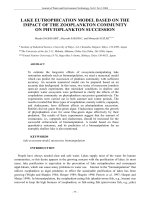BIRDS OF THE INDIAN
Bạn đang xem bản rút gọn của tài liệu. Xem và tải ngay bản đầy đủ của tài liệu tại đây (3.83 MB, 272 trang )
BIRDS OF THE
INDIAN HILLS
m^ BY DOUGLAS DF.WAT^ mm
ALBERT R. MANN
LIBRARY
New York
State Colleges
OF
Agriculture and
Home Economics
Cornell University
Cornell University Library
QL
691.I4D51
Birds of the Indian
Hills.
3 1924 000 067 912
"BIRDS
OF THE INDIAN
HILLS
'Br
THE SAME AUTHOR
ANIMALS OF NO IMPORTANCE.
THE INDIAN CROW— HIS BOOK.
BOMBAY DUCKS.
BIRDS OF THE PLAINS.
INDIAN BIRDS.
JUNGLE FOLK.
GLIMPSES OF INDIAN BIRDS.
IN COLLABORATION WITH FRANK FINN
THE MAKING OF
SPECIES.
BIRDS OF THE
INDIAN HILLS
BT DOUGLAS DEWAR
tA
COMPANION VOLUME
a
a
a
TO
THE BIRD VOLUMES OF " THE
FAUNA OF BRITISH INDIA"
LONDON JOHN LANE, THE BODLET HEAD
NEW rORK: JOHN LANE COMPANY
TORONTO: BELL {s* COCKBURN
MCMXF
:
(pL
All rights reserved
Printed by
Ballantynk, Hanson &• Co.
at the Ballantyne Press,
Edinburgh
Considerable portions of
this
book have
already-
appeared as articles in one or other of the following
newspapers or periodicals
:
The
Pioneer,
Englishman, Indian Field, Bird Notes.
Madras Mail,
I
am
indebted
to the editors of the above publications for permission
to republish the portions of the
appeared in print.
book that have already
CONTENTS
PART
I
....
Birds of the Himalayas
Introduction
The Habitat of Himalayan Birds
The Common Birds of the Western
Himalayas
The Common
9
II
13
29
Birds of the Eastern
Himalayas
105
Tits at Work
The Pekin-Robin
Black Bulbuls
A Warbler of Distinction
The Spotted Forktail
133
138
The Nest of the Grey-winged Ouzel
The Black-and-yellow Grosbeak
The Great Himalayan Barbet
164
127
.
145
151
.
158
174
PART n
The Common
Birds of the Nilgiris
PART
The Common
.
.
181
.
233
III
Birds of the Palni Hills
Appendices
249
Index
258
PART
I
Birds of the Himalayas
INTRODUCTION
The
It
avifauna of the Himalayas
a large one.
is
includes birds found throughout the range,
birds confined to the eastern or western portions, birds resident all
that
are
through the
mere seasonal
visitors,
year, birds
found
birds
only at high elevations, birds confined to the
lower hills, birds abundant everywhere, birds
nowhere common. Most ornithological books
treat of all these sorts and conditions of birds
impartially, with the result that the non-orni-
thological reader
who
dips
into
them
finds
himself completely out of his depth.
He who
plunges into the essays that follow
need have no fear of getting out of his depth.
With the object of guarding against this catashave described as few birds as possible.
I have ignored all those that are not likely to
be seen daily in summer in the Himalayas at
trophe,
I
elevations between
5000 and 7000
feet
above
of the
Moreover, the birds
sea-level.
Western have been separated from those of the
the
Birds of the Indian Hills
The
Eastern Himalayas.
peruses this
paratively
little
book
will
result
meets them
should
drawbacks.
recognising
in the flesh.
the fact that the
Some
that he
who
be confronted with com-
few birds, and
difficulty in
is
am
I
method
I
experience
them when he
fully alive to
have adopted has
readers are likely to
come
across birds at the various hill stations which
do not
find
place
doubtless charge
in
me
meet these charges
book.
this
Such
will
with sins of omission.
in anticipation
I
by adopting
the defence of the Irishman, charged with the
whose crime had been wit" For every witness
nessed by several persons
who saw me steal the chicken, I'll bring twenty
theft of a chicken,
:
who didn't see me steal it
The reader will come
"
!
across twenty birds
which the essays that follow
will enable
him
to identify for every one he sees not described
in
them.
—
THE HABITAT OF HIMALAYAN
'BIRDS
Himalayan
birds inhabit what is perhaps the
most wonderful tract of country in the world.
The Himalayas are not so much a chain of
mountains as a mountainous country, some
eighty miles broad and several hundred long
a
country composed entirely of mountains and
valleys with
There
is
no large plains or broad plateaux.
a saying of an ancient Sanskrit poet
which, being translated into English, runs
:
" In
hundred ages of the gods I could not tell
you of the glories of Himachal." This every
writer on things Himalayan contrives to drag
a
into his
Some begin with
composition.
quotation, while others reserve
and make
it
do duty
stylists assure
Some
only
to
mock
beauties of the
—
for the
the
last,
for the epigram which
us should terminate every essay.
there are
exaggerated
it
who quote
the Indian sage
Such assert that the
Himalayas have been greatly
him.
that,
as regards grandeur, their
13
Birds of the Indian Hills
scenery compares
the Andes, while their beauty
I
am
unable to
criticise
surpassed by
is
seen the Andes,
Not having
that of the Alps.
that of
unfavourably with
the assertion regarding
the grandeur of the Himalayas, but
find
I
it
to imagine anything finer than their
difficult
scenery.
As
regards beauty, the Himalayas at their
best surpass the Alps, because they exhibit far
more
and present
variety,
grander
on
everything
a
scale.
The Himalayas are a kind of Dr.
They have two faces
—
and Mr. Hyde.
and the plain.
Those of the
In
May
they are
Jekyll
the fair
at their worst.
which are not afforested
and desolate, and the valleys,
hillsides
are brown, arid,
in addition to being unpleasantly hot, are
and dusty.
freshness,
The
foliage
of the
and everywhere there
is
trees
a
dry
lacks
remarkable
absence of water, save in the valleys through
which the rivers flow.
September is the month
attain
The
falls,
the
other
hand,
which the Himalayas
perfection or something approaching it.
eye
is
refreshed by the
garment which the
The
On
foliage
in
is
cascades,
hills
bright emerald
have newly donned.
and luxuriant. Watermighty torrents and rivulets
green
14
Habitat of Himalayan Birds
Himachal has been converted into
monsoon rains.
A remarkable feature of the Himalayas is
the abruptness with which they rise from the
In some parts there
plains in most places.
but speaking generally the
are low foothills
mountains that rise from the plain attain a
height of 4000 or 5000 feet.
abound.
fairyland by the
;
It
any person who has not
Himalayas
difficult for
is
passed from the
plains of India to the
to realise fully the vast difference between the
two countries and the dramatic suddenness
with which the change takes place.
The
cake
—
plains are as flat as the proverbial pan-
dead monotony of cultivated alluvium,
a
square mile upon square mile of wheat,
rice,
vetch, sugar-cane, and other crops, amidst which
mango
bamboo clumps, palms, and
groves,
hamlets are scattered promiscuously.
places the hills rise sheer
from
In
this, in
some
others
they are separated from the alluvial plains by
belts
of
Bhabar.
covered
known
country
The
with
monotonous.
Tarai
tall,
This
as
the
Tarai
feathery grass, beautifully
is
succeeded by a stretch
of gently-rising ground, 10 or 20
breadth,
known
as
and
low-lying, marshy land
is
the
15
Bhabar
—
a
miles
in
strip
of
Birds of
the
Indian Hills
composed mainly of tall evergreen sal
These trees grow so
robustd).
forest
trees [Shorea
close
together that the
forest
is
difficult
penetrate, especially after the rains,
when
to
the
Very beautidense and rank.
to the
stimulating
ful is the Bhabar, and very
imagination.
One writer speaks of it as " a
undergrowth
jungle
is
rhapsody,
an
extravagant,
botanical tour de force, intensely
Titanic, incoherent
home of
impossible
modern
magnificence."
It
in its
is
the
the elephant, the tiger, the panther,
the wild boar, several species of deer, and of
many strange and beautiful birds.
Whether from the flat plains or
the gently-
sloping Bhabar, the mountains rise with startling
suddenness.
The
flora
and fauna of the Himalayas
diflFer
from those of the neighbouring plains as greatly
as the trees and animals of England differ from
those of Africa.
Of the common
— the
trees of the plains of India
mango, babul, tamarind, shesham,
palm, and plantain
not one is to be found
growing on the hills. The lower slopes are
nim,
—
covered with sal trees like the Bhabar.
cease to
grow
at elevations
of 3000
These
feet
the sea-level, and, higher up, every rise of
16
above
1000
Habitat of Himalayan Birds
feet
means
tropical
change
a considerable
Above the
in the flora.
come several species of
evergreen trees, among the stems and
sal belt
branches of which great creepers entangle themselves in
4000
fantastic figures.
At
elevations
of
feet the long-leaved pine {^Pinus longifolia)
From 5000
10,000 feet, several
Above 6000
species of evergreen oaks abound.
appears.
feet
are
be
to
deodar and other
seen
to
the
rhododendron, the
hill cypresses,
On
ful horse-chestnut.
and the beauti-
the lower slopes the
undergrowth is composed largely of begonias
Higher up maidenhair and
and berberry.
other ferns abound, and the trunks of the oaks
and rhododendrons are festooned with hanging
moss.
Between elevations of 10,000 and 12,000
the silver
fir
is
feet
commonest tree. Above
become stunted and dwarfed,
the
12,000 feet the firs
on account of the low temperatures that prevail, and juniper and birch are the characteristic
trees.
There are spots in the Himalayas, at heights
varying from 10,000 to 12,000 feet, where
wild raspberries grow, and the yellow colt'sfoot,
the
dandelion,
the
blue
gentian,
the
Michaelmas daisy, the purple columbine, the
17
B
Birds of the Indian Hills
centauria, the anemone, and the edelweiss occur
Orchids grow in large numbers
most parts of the Himalayas.
Every hillside is not covered with foliage.
in profusion.
in
Many
are
rugged and
too
precipitous
are
masses
hillsides
to
bare.
Some of
these are
sustain vegetation, others
of quartz and granite.
On
the
most exposed to the wind, only grass
and small shrubs are able to obtain a foothold.
" On the vast ridges of elevated mountain
masses," writes Weber in The Forests of Upper
India,
" which constitute the
found
different regions
The
Himalayas
of distinct
are
character.
peaks of the snowy range abutting
on the great plateaux of Central Asia and Tibet
run
loftiest
like a great belt across the globe, falling
towards the south-west to the plains of India.
Between the summit and the plains, a distance
of 60 to 70 miles, there are higher, middle,
and lower ranges, so cut up by deep and winding valleys and river-courses, that no labyrinth
could be found more confusing or difficult
to unravel.
There is nowhere any tableland,
as at the Cape or in Colorado, with horizontal
of rock cut down by water into valleys
or canons.
The strata seem, on the contrary,
to have been shoved up and crumpled in all
strata
Habitat of Himalayan Birds
directions
by some powerful shrinkage of the
due perhaps to cooling and the
such a jumble of contorted rock
earth's crust,
result
is
;
masses, that
it
looks as if some great castle
had been blown up by dynamite and
hurled
in
directions.
all
The
its
great
walls
central
masses, however, consist generally of crystalline
and quartz rock, protruding
from the bowels of the earth and shoving up
granite,
gneiss,
the stratified envelope of rocks nearly 6 miles
above
.
.
.
sea-level.
.
.
.
The
higher you get up
the rougher and more difficult becomes
the climbing
;
the valleys are deeper and
cut into ravines, the rocks
more
fantastically
and rudely torn asunder, and the very
the earth exposed
;
more
vitals
while the heights
of
above
tower to the skies. The torrents rushing from
under the glaciers which flow from the snowclad summits roar and foam, eating their way
ever into the misty gorges."
Those who have not
may
visited the
Himalayas
perhaps best obtain an idea of the nature
of the country from a brief description of that
from the plain to
the path from
Let
take
the snowy range.
us
Kathgodam, the terminus of the Rohilkhand
traversed by a path leading
and
Kumaun
railway, to the Pindari glacier.
19
Birds of the Indian Hills
For the
two miles the journey is along
the cart-road to Naini Tal, on the right bank
of the Gola river.
At Ranibagh the pilgrim to the Pindari
first
glacier leaves the cart-road
path which,
having
and follows a bridlethe Gola by a
crossed
suspension bridge, mounts the steep hill on
the left bank.
Skirting this hill on its upward
course, the road reaches the far side, which
A
down to the Barakheri stream.
fairly
steep ascent of 5 miles through well-wooded
country brings the traveller to Bhim Tal, a
slopes
lake
4500
This
lake,
acres,
is
feet
above
of which
the
of the
level
the area
sea.
about
150
one of the largest of a series of lakes
formed by the flow of mountain streams into
cup-like valleys.
The
path
is
skirts
the lake
and then ascends the Gagar range, which
a
height of over
7000
over this range a very
To
feet.
fine
From
view
is
attains
the pass
obtainable.
the north the
between it
and valley.
snowy range stretches, and
and the pass lie 60 miles of mountain
To the south are to be seen Bhim
Tal, Sat Tal, and other lakes, nestling in
the
outer ranges, and, beyond the hills, the
vast
expanse of the plains.
The Gagar
range
is
well
wooded.
The
Habitat of Himalayan Birds
majority of the trees are rhododendrons
when they put
3
these,
forth their blossoms in spring,
mass of crimson colouring.
display a
the
:
From
Gagar pass the road descends for some
miles through forest to the valley of the
Ramganga. For about a mile the path follows
it
then
the left bank of this small stream
;
crosses
begins
it
by
to
a
suspension bridge, and forthwith
mount
gradually the
On
Pathargarhi mountain.
a few
hundred
feet
bare
rocky
the mountain side,
above the Ramganga,
is
a
village of three score double-storeyed houses.
These are very picturesque. Their white walls
But
are set off by dark brown woodwork.
alas
they are as whited sepulchres.
from a distance that they
They are typical abodes of the
From
are
It is
only
picturesque.
hill folk.
the Pathargarhi pass the path
makes
well-wooded mounAfter crossstream.
Deodar
the
tain-side to
ing this by a stone bridge, the path continues
its switch-back course upwards on a wooded
hillside to the Laldana Binaik pass, whence it
descends gradually for 6 miles, through first
a
steep descent
down
a
rhododendron then pine forest to the Sual
This river is crossed by a suspension
river.
From the Sual the path makes an
bridge.
21









